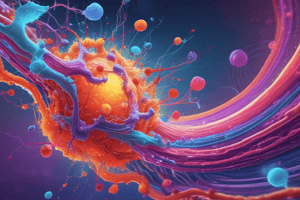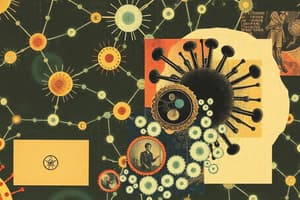Podcast
Questions and Answers
Which of the following is NOT a method of chemical transmission for signalling molecules?
Which of the following is NOT a method of chemical transmission for signalling molecules?
- Endocrine
- Paracrine
- Transmembrane (correct)
- Autocrine
What characterizes hydrophobic signalling molecules?
What characterizes hydrophobic signalling molecules?
- They usually bind to intracellular receptors. (correct)
- They are generally soluble in water.
- They do not easily penetrate the cell membrane.
- They typically act on cells at a distance.
In the stimulus-response model, what is the primary role of signal transduction?
In the stimulus-response model, what is the primary role of signal transduction?
- To amplify and convey the signal within the cell. (correct)
- To maintain cellular homeostasis.
- To detect the external stimuli.
- To release signalling molecules into the bloodstream.
Which of these pathways is classified as an extrinsic pathway of apoptosis?
Which of these pathways is classified as an extrinsic pathway of apoptosis?
What is a distinguishing feature of neurotransmitters compared to hormones?
What is a distinguishing feature of neurotransmitters compared to hormones?
Which statement about cytokinins is accurate?
Which statement about cytokinins is accurate?
Apoptosis can occur through which of the following mechanisms?
Apoptosis can occur through which of the following mechanisms?
What function do arteries serve in the circulatory system?
What function do arteries serve in the circulatory system?
What is the primary site for the exchange of materials in the circulatory system?
What is the primary site for the exchange of materials in the circulatory system?
Why can't gases and materials pass through arteries and veins?
Why can't gases and materials pass through arteries and veins?
How do substances diffuse between capillaries and cells?
How do substances diffuse between capillaries and cells?
What prevents the flow of fluid in lymph vessels?
What prevents the flow of fluid in lymph vessels?
What characteristic of capillaries allows them to be effective in material exchange?
What characteristic of capillaries allows them to be effective in material exchange?
Which statement correctly describes capillary networks?
Which statement correctly describes capillary networks?
What role does interstitial fluid play in the exchange process?
What role does interstitial fluid play in the exchange process?
What is the primary function of tight junctions in animal cells?
What is the primary function of tight junctions in animal cells?
Which type of junction is primarily responsible for allowing selective passage of ions and small molecules between adjacent cells?
Which type of junction is primarily responsible for allowing selective passage of ions and small molecules between adjacent cells?
What role do adhesion junctions play in animal tissues?
What role do adhesion junctions play in animal tissues?
How are the four types of tissues in the animal body primarily differentiated?
How are the four types of tissues in the animal body primarily differentiated?
Which of the following organ systems is involved in the homeostatic response to a rise in body temperature?
Which of the following organ systems is involved in the homeostatic response to a rise in body temperature?
What type of molecules are hydrophilic signaling molecules unable to do?
What type of molecules are hydrophilic signaling molecules unable to do?
In a negative feedback system responding to increased body temperature, what role do effectors play?
In a negative feedback system responding to increased body temperature, what role do effectors play?
Which of the following is an example of a hydrophobic signaling molecule?
Which of the following is an example of a hydrophobic signaling molecule?
What occurs during a heart attack related to the coronary arteries?
What occurs during a heart attack related to the coronary arteries?
What is the basic requirement for internal transport in larger multicellular animals?
What is the basic requirement for internal transport in larger multicellular animals?
What role do hormones play in living organisms?
What role do hormones play in living organisms?
Where do hydrophilic signaling molecules bind when they reach a target cell?
Where do hydrophilic signaling molecules bind when they reach a target cell?
What type of hormones are insulin and glucagon classified as?
What type of hormones are insulin and glucagon classified as?
How are most hydrophilic signaling molecules transported in the body?
How are most hydrophilic signaling molecules transported in the body?
What is the primary function of the endocrine system?
What is the primary function of the endocrine system?
In which part of the cycle do steroids primarily exert their influence?
In which part of the cycle do steroids primarily exert their influence?
What is the primary reason for programmed cell death in multicellular organisms?
What is the primary reason for programmed cell death in multicellular organisms?
Which of the following triggers apoptosis?
Which of the following triggers apoptosis?
Why do lymphocytes die by apoptosis after an infection has been cleared?
Why do lymphocytes die by apoptosis after an infection has been cleared?
How does apoptosis contribute to the development of human hands in embryos?
How does apoptosis contribute to the development of human hands in embryos?
Which statement about individuals with Type II diabetes is correct?
Which statement about individuals with Type II diabetes is correct?
What does the process of apoptosis ensure in a multicellular organism?
What does the process of apoptosis ensure in a multicellular organism?
Which of the following best describes apoptosis?
Which of the following best describes apoptosis?
What is one of the roles of apoptosis in response to infections?
What is one of the roles of apoptosis in response to infections?
What is the primary role of auxin (IAA) in plants?
What is the primary role of auxin (IAA) in plants?
When a plant experiences phototropism, what causes the bend toward the light?
When a plant experiences phototropism, what causes the bend toward the light?
Where is auxin primarily produced in a plant?
Where is auxin primarily produced in a plant?
How does auxin influence the rate of growth on either side of the plant stem during phototropism?
How does auxin influence the rate of growth on either side of the plant stem during phototropism?
What is the significance of plant hormones being produced in low concentrations?
What is the significance of plant hormones being produced in low concentrations?
What happens to the auxin distribution when a plant receives light from one direction?
What happens to the auxin distribution when a plant receives light from one direction?
Which of the following correctly describes the mechanism of bending in plants due to phototropism?
Which of the following correctly describes the mechanism of bending in plants due to phototropism?
Which statement about auxin's role in phototropism is incorrect?
Which statement about auxin's role in phototropism is incorrect?
Flashcards
Animal Cell Junctions
Animal Cell Junctions
Structures that connect animal cells, facilitating communication and interaction. There are three main types: tight junctions, adhesion junctions, and gap junctions.
Tight Junction
Tight Junction
Junctions that form a watertight seal between animal cells, preventing leakage. Forms a barrier to substances.
Adhesion Junction
Adhesion Junction
Junctions that connect animal cells mechanically, providing structural integrity and resisting mechanical stress. Act as an adhesive.
Gap Junction
Gap Junction
Signup and view all the flashcards
Animal Tissues
Animal Tissues
Signup and view all the flashcards
Homeostasis
Homeostasis
Signup and view all the flashcards
Negative Feedback System
Negative Feedback System
Signup and view all the flashcards
Internal Transport (Animals)
Internal Transport (Animals)
Signup and view all the flashcards
Blood vessels
Blood vessels
Signup and view all the flashcards
Arteries
Arteries
Signup and view all the flashcards
Capillaries
Capillaries
Signup and view all the flashcards
Veins
Veins
Signup and view all the flashcards
Material Exchange
Material Exchange
Signup and view all the flashcards
Capillary Walls
Capillary Walls
Signup and view all the flashcards
Interstitial Fluid
Interstitial Fluid
Signup and view all the flashcards
Lymphatic System
Lymphatic System
Signup and view all the flashcards
Cell Signalling
Cell Signalling
Signup and view all the flashcards
Autocrine Signalling
Autocrine Signalling
Signup and view all the flashcards
Paracrine Signalling
Paracrine Signalling
Signup and view all the flashcards
Endocrine Signalling
Endocrine Signalling
Signup and view all the flashcards
Gap Junction Signalling
Gap Junction Signalling
Signup and view all the flashcards
Hydrophobic Signalling Molecules
Hydrophobic Signalling Molecules
Signup and view all the flashcards
Hydrophilic Signalling Molecules
Hydrophilic Signalling Molecules
Signup and view all the flashcards
Stimulus-Response Model
Stimulus-Response Model
Signup and view all the flashcards
What do hormones do?
What do hormones do?
Signup and view all the flashcards
What is the endocrine system?
What is the endocrine system?
Signup and view all the flashcards
Insulin
Insulin
Signup and view all the flashcards
Glucagon
Glucagon
Signup and view all the flashcards
Steroid hormones
Steroid hormones
Signup and view all the flashcards
Peptide hormones
Peptide hormones
Signup and view all the flashcards
Plant Hormones
Plant Hormones
Signup and view all the flashcards
Auxin (IAA)
Auxin (IAA)
Signup and view all the flashcards
Phototropism
Phototropism
Signup and view all the flashcards
How does Auxin cause Phototropism?
How does Auxin cause Phototropism?
Signup and view all the flashcards
Cell Expansion
Cell Expansion
Signup and view all the flashcards
Plant Growth Response
Plant Growth Response
Signup and view all the flashcards
Hormone's Role in Plant Physiology
Hormone's Role in Plant Physiology
Signup and view all the flashcards
Plant Hormones vs. Animal Hormones
Plant Hormones vs. Animal Hormones
Signup and view all the flashcards
Apoptosis
Apoptosis
Signup and view all the flashcards
Why is apoptosis needed?
Why is apoptosis needed?
Signup and view all the flashcards
Apoptosis example: Lymphocytes
Apoptosis example: Lymphocytes
Signup and view all the flashcards
Apoptosis example: Webbing
Apoptosis example: Webbing
Signup and view all the flashcards
Triggers of Apoptosis
Triggers of Apoptosis
Signup and view all the flashcards
Type II Diabetes: Insulin Resistance
Type II Diabetes: Insulin Resistance
Signup and view all the flashcards
Cell Signalling in Apoptosis
Cell Signalling in Apoptosis
Signup and view all the flashcards
Apoptosis: A Precise Process
Apoptosis: A Precise Process
Signup and view all the flashcards
Study Notes
No specific topic provided. Please provide the text or questions for which you would like study notes.
Studying That Suits You
Use AI to generate personalized quizzes and flashcards to suit your learning preferences.
Related Documents
Description
Test your knowledge on the roles of signalling molecules in both animal and plant communication, as well as the functions of various components in the circulatory system. This quiz covers important concepts such as signal transduction, neurotransmitters, and the mechanisms of apoptosis. Challenge yourself and solidify your understanding of these biological processes.



